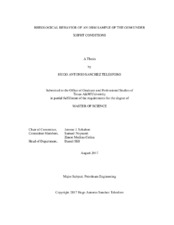| dc.description.abstract | The scope of this research is to study the rheological behavior of an oil based mud (OBM) sample from the Mexican side of the Gulf of Mexico (GOM) under extreme conditions of High Pressure High Temperature (HPHT). In the coming years many HPHT wells are going to be drilled in this area of the GOM. Currently Mexican Oil and Gas industry is already open to international operators because the Mexican energy reform has been approved, so it is important to study the possible drilling fluids that will be used. These fluids can be within any of these 3 tiers of HPHT classification: HPHT, ultra (uHPHT) or extreme (xHPHT).
The sample was submitted to extreme HPHT conditions, by using the state-of-the-art Model 7600 HPHT Viscometer that is capable of measuring drilling fluid properties up to 40,000 psi and 600 °F. During the laboratory tests performance, it was noticed that erroneous results were obtained by several mechanical failures. It should be noted that the spare parts take a long time to arrive-around 3 weeks. One of the failures was that the pivot of the spring assembly got inside the device, so the bob was spinning nonstop. For this reason the readings of the dial went well beyond the allowed range; another mechanical failure was that the spring of the spring assembly was loose, which did not allow us to obtain a correct reading of shear stress at high pressures and low temperatures; also the baffle does not separate the pressurizing oil from the sample, mixing these two fluids and obviously affecting the properties of the sample. This was noticed by running one test with baffle and another without it getting very similar results.
The rheological behavior of the sample showed that the viscosity is inversely proportional to temperature and directly proportional to pressure, noticing a failure point at 300 °F, because of sample degradation.
Moreover the rheogram’s curves obtained are quite similar to a second degree polynomial function, with R-squared values ranging from 0.95 to 0.99; hence an equation can be adjusted in the future by extrapolating different pressure and temperature values. | en |


